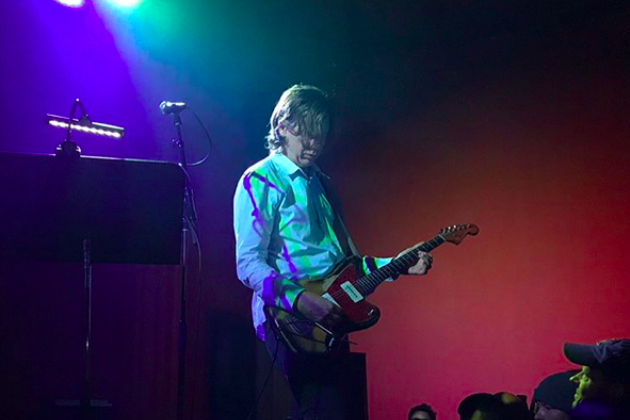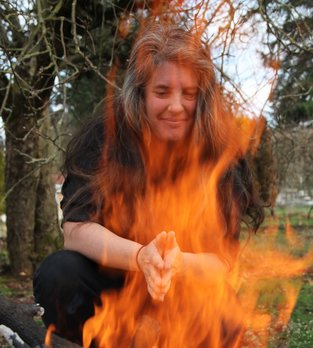|
Written by Ronny Kerr 
Impressions of live performances by the Thurston Moore Group (led by the guitar legend of Sonic Youth fame) and experimental folk musician Marisa Anderson, who played the Chapel in San Francisco on May 12, 2017.
What should one expect from a concert by a super famous musician of the underground? When we see Neil Young or Paul McCartney or Fleetwood Mac we forgive their wrinkles and hope for the best, knowing full well that both musician and fan have passed their prime.
But what about someone who never fully reached stardom? What about someone whose most prominent album—the one with the Gerhard Richter on the cover—dates from the 1980s, back when he still had a wife to make albums with? I’m no Sonic Youth aficionado but I know I love EVOL and Daydream Nation. The one that introduced me to the band was Murray Street, an album from the high school days, when I still discovered music at public libraries. And, of course, there will always be a special place in my heart for Ciccone Youth because nothing can go wrong when a noise rock band covers Madonna. So what’s Thurston been up to lately? Do I care? Should I care? I should, I think to myself while riding to the show. If I love music, humanity, and the endless striving for expression, speaking through the soul, then I should care. So these became the core questions: does Thurston still speak through his soul? And does it sound good? 
Opening the night was Marisa Anderson, a solo guitarist from Portland. Playing electric and not singing a note, the wild-haired hippie woman purified the crowd—at least those who were listening—with patient, psychedelic folk that meandered down frayed, dark passages. One of her pieces, “Resurrection,” drew inspiration from a book on geology called Deep Time, which she extrapolated into a musical meditation on how all the elements of the universe are here and forever changing.
Another highlight was a medley of “House Carpenter” and “See That My Grave Is Kept Clean," reimagining the pieces not just sonically but also narratively. By ending the medley with “Grave,” she humbly dusted off the much-sullied memory of the carpenter’s wife. After all she asked, “Who hasn’t fallen in love with the devil?” Her essential trick divided the lyrical content from the music itself. Instead of telling the story while performing, she would tell the story and then play the song. So instead of spacing out during her psychedelic, meandering performances and thinking about wherever your mind wandered, you would instead be thinking about the guy at the British expat bar in the Spanish beach town who asked Marisa, “Why don’t you play happy songs?” With short, deeply layered pieces, Marisa’s instrumental folk goodness set the ideal foundation for the evening.
A short while later, Thurston’s set began with the man walking out on stage alone. People cheered a bit, but that died down quickly. (Perhaps the precise opposite of teeny boppers at a pop show is a bunch of middle-aged men at a noise rock show.) Giant, lanky, and dressed in a crisp, long-sleeved white shirt, Thurston methodically lifted his guitar, checked the tuning, and dove into his new single “Cease Fire” with a ping-pong rhythm of high notes. As he played, the rest of the group emerged onstage and joined with him to give us what we came for: throwback shoegazy goodness.
“PUT YOUR PHONE DOWN,” yelled some angry old man behind me at some guy filming in front of me. I hope the heckler didn’t mind me taking notes on my phone. But he had a point. This was music meant to arrest; documenting it would benefit nobody. Thurston sang more than Marisa had, but just barely. The lyrical content largely accented the jams that extended into morphing, rhythmic mantras, woven with guitar solos that refused to take center stage. This wasn’t about Thurston. It was about the music. Moreso, it was about the tone. The third “song” could have been the end of one or the beginning of another, a massive ambient interlude buoyed by noise, distortion, and delicious tone. It could have been Richard D. James or Brian Eno up there, but instead it was the Thurston Moore Group, blanketing us in a heavenly aura. When its reign came to an end, a man next to me said aloud, “How does he make those sounds?” Behind the group, overused NASA photos of nebulae provided a backdrop to Thurston’s singing of “smoking ghosts” and Rock n Roll Consciousness, the name of his new album. But I hardly saw anything at all, except the inside of my mind and its reflections of the universe. How long were these songs? When one would end, I would look up and wonder, how long have I been here? And then the next would begin, and I would slowly be whisked away once again to a land of somnolence and gravity. Communicate. Connect. This was Thurston’s only mandate and suggestion, as he began his encore, for surviving the politics of our time. He baptized us one last time in his heavy, meticulously perfected tones, and the connection was made true. He had communicated through his soul, and I felt blessed.
0 Comments
Leave a Reply. |
Categories
All
Photo Gallery & Live Review Archives
June 2024
|

 RSS Feed
RSS Feed